Realtek Semiconductor RTL8192SE 802.11 b/g/n RTL8192SE miniCard User Manual
Realtek Semiconductor Corp. 802.11 b/g/n RTL8192SE miniCard
Contents
- 1. Manual
- 2. User Manual 1
- 3. User Manual 2
Manual
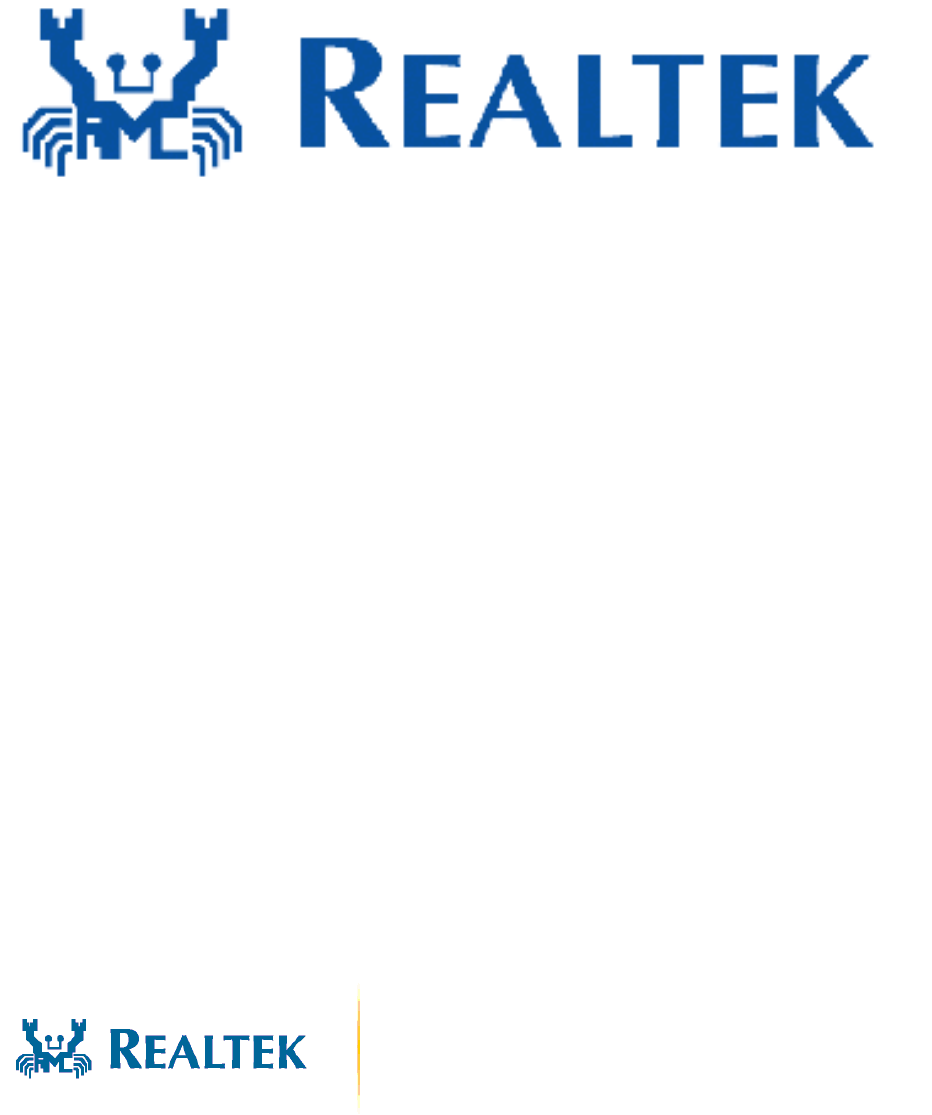
802.11 b/g/n RTL8192SE miniCard
User’s Manual
Rev. 1.0
21 Apr 2009
Realtek Semiconductor Corp.
No. 2, Innovation Road II, Hsinchu Science Park, Hsinchu 300, Taiwan
Tel.: +886-3-578-0211. Fax: +886-3-577-6047
www.realtek.com.tw
RTL8192SE

RTL8192SE
User’s Manual
ii Rev.1.0
COPYRIGHT
©2009 Realtek Semiconductor Corp. All rights reserved. No part of this document may be reproduced,
transmitted, transcribed, stored in a retrieval system, or translated into any language in any form or by any
means without the written permission of Realtek Semiconductor Corp.
DISCLAIMER
Realtek provides this document “as is”, without warranty of any kind, neither expressed nor implied,
including, but not limited to, the particular purpose. Realtek may make improvements and/or changes in
this document or in the product described in this document at any time. This document could include
technical inaccuracies or typographical errors.
TRADEMARKS
Realtek is a trademark of Realtek Semiconductor Corporation. Other names mentioned in this document are
trademarks/registered trademarks of their respective owners.
USING THIS DOCUMENT
This document is intended for the software engineer’s reference and provides detailed programming
information.
Though every effort has been made to ensure that this document is current and accurate, more information
may have become available subsequent to the production of this guide. In that event, please contact your
Realtek representative for additional information that may help in the development process.
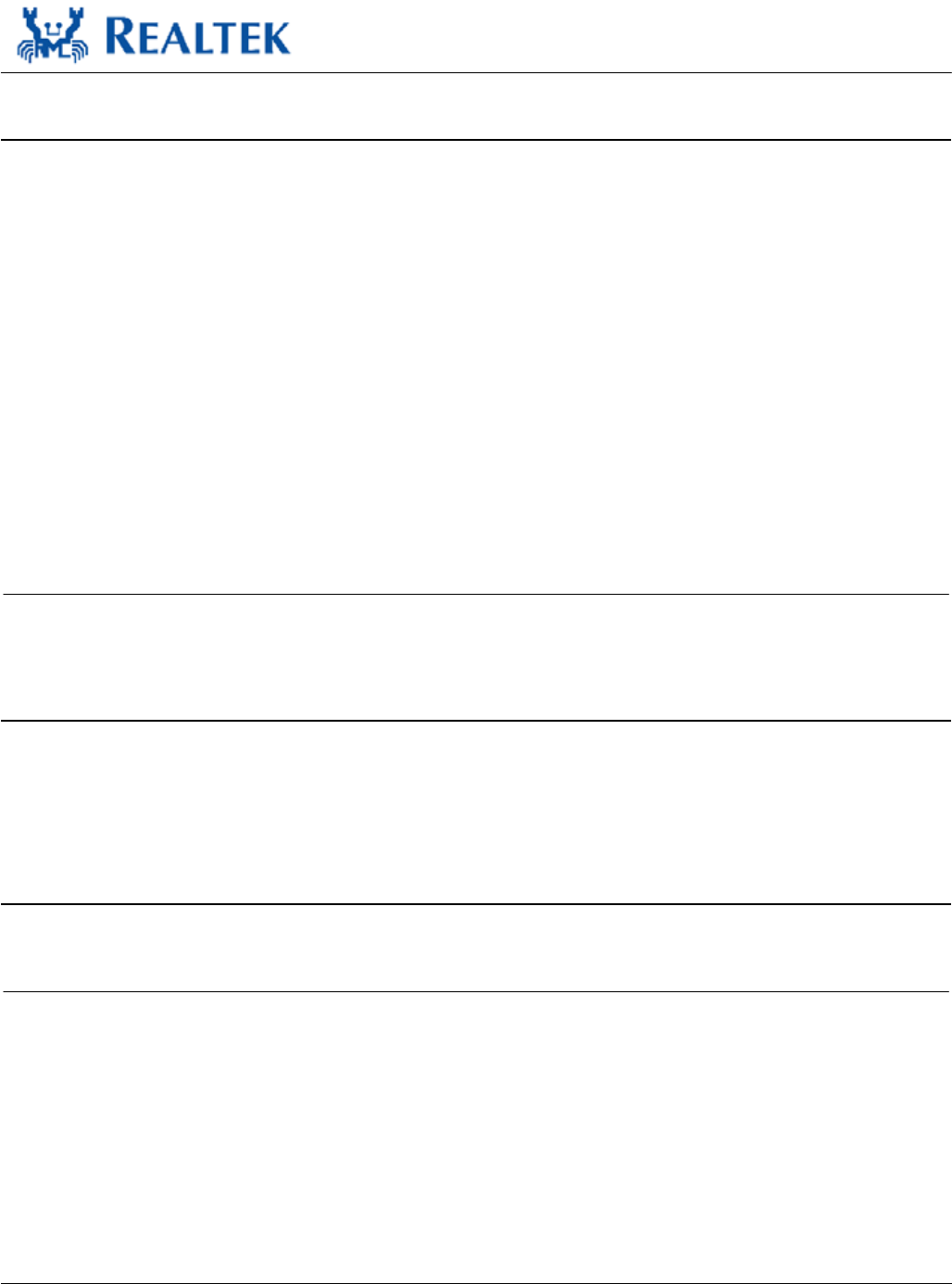
RTL8192SE
User’s Manual
iii Rev.1.0
Table of Contents
1. GENERAL DESCRIPTION................................................................................................................................................4
2. GENERAL FEATURES ......................................................................................................................................................5
3. BLOCK DIAGRAM ............................................................................................................................................................7
4. PRODUCT SPECIFICATIONS..........................................................................................................................................8
4.1. MINI PCI EXPRESS PIN ASSIGNMENT..............................................................................................................................8
4.2. MECHANICAL..................................................................................................................................................................9
4.3. ENVIRONMENTAL ............................................................................................................................................................9
4.3.1. Operating ...............................................................................................................................................................9
4.3.2. Storage....................................................................................................................................................................9
4.4. FUNCTIONAL SPECIFICATIONS .........................................................................................................................................9
4.5.
Warning…………………………………………………………………………………………………………………..9
4.5.1 Federal Communication Commission Interference Statement…….……………………………………………..10
4.5.2 Industry Canada Statement……………………………………………………………………………………….12
4.5.3 NCC警語…………………………………………………………………………………………………………13
List of Tables
TABLE 1. MINI PCI EXPRESS PIN ASSIGNMENT ............................................................................................................................8
TABLE 2. FUNCTIONAL SPECIFICATIONS .......................................................................................................................................9
List of Figures
FIGURE 1. SINGLE BAND 11N APPLICATION DIAGRAM .................................................................................................................7
FIGURE 2. RTL8192SE MINICARD MECHANICAL SPECIFICATION ................................................................................................9

RTL8192SE
User’s Manual
4 Rev.1.0
1. General Description
The Realtek RTL8192SE miniCard is a highly integrated MIMO wireless LAN (WLAN) used for high
speed wireless local network access. The card is built with a MAC and 2T2R capable RF/baseband single
chip RTL8192SE.
The RTL8192SE miniCard implements multiple input, multiple output (MIMO) orthogonal frequency
division multiplexing (OFDM) with 2 transmit and 2 receive paths and is compatible with 802.11n Draft
specification 2.0. Other features include two spatial streams transmission, Long guard interval (GI) of
800ns, spatial spreading, and transmission over 20 MHz and 40 MHz bandwidth. Moreover, RTL8192SE
provides one spatial stream space-time block code (STBC) to extend the range of transmission. At the
receiver, extended range and good minimum sensitivity is achieved by having receiver diversity up to 2
antennas. As the recipient, the RTL8192SE miniCard also supports explicit sounding packet feedback that
helps senders with beamforming capability.
For legacy compatibility, direct sequence spread spectrum (DSSS), complementary code keying (CCK)
and OFDM baseband processing are included to support all 802.11b, and 802.11g data rates. Differential
phase shift keying modulation schemes, DBPSK and DQPSK with data scrambling capability, are available
along with complementary code keying to provide the data rates of 1, 2, 5.5 and 11Mbps with long or short
preamble. The high speed FFT/IFFT paths, combined with BPSK, QPSK, 16QAM, and 64QAM
modulation of the individual subcarriers and rate compatible punctured convolutional coding with coding
rate of 1/2, 2/3, 3/4, and 5/6, provides the maximum data rate of 54 Mbps and 300 Mbps for IEEE 802.11g
and 802.11n MIMO OFDM respectively.
The RTL8192SE PCI-E miniCard supports 802.11e for multimedia applications, 802.11i for security, and
802.11n for enhanced MAC protocol efficiency. Using packet aggregation techniques such as A-MPDU
with BA and A-MSDU, protocol efficiency is significantly improved. Power saving mechanisms such as
U-APSD, APSD, and MIMO power saving reduces the power wasted during idle time, and compensates for
the extra power required to transmit MIMO OFDM. The RTL8192SE PCI-E miniCard provides simple
legacy and 20Mhz/40Mhz co-existence mechanisms to ensure backward and network compatibility.

RTL8192SE
User’s Manual
5 Rev.1.0
2. General Features
General
• Operate at ISM frequency bands (2.4GHz)
• IEEE standards support: IEEE 802.11b, 802.11g, draft 802.11n
• Mini PCI Express interface
• Enterprise level security which can apply WPA2 certification
• 2 transmitter and 2 receivers allow data rates supporting up to 300 Mbps downstream and 300 Mbps
upstream PHY rates.
• Full-featured software utility for easy configuration and management
• Power savings features and low power consumptions for mobile powered applications
• Rohs compliance
Host Interface
• Complies with PCI Express™ Base Specification Revision 1.1
Standards supported
• IEEE 802.11b/g/n compatible WLAN
• 802.11e QoS Enhancement (WMM, WMM-SA Client mode)
• 802.11i (WPA, WPA2). Open, shared key, and pair-wise key authentication services.
• Cisco Compatible Extensions (CCX4)CCX
MAC Features
• Frame aggregation increase MAC efficiency (A-MSDU, A-MPDU)
• Low latency Immediate High-Throughput Block Acknowledgement (HT-BA)
• Long NAV for media reservation with CF-End for NAV release
• PHY-level spoofing to enhance legacy compatibility
• MIMO power saving mechanism
• Channel management and co-existence
• Multiple BSSID feature allowing RTL8192SE to assume multiple MAC identity when used as
wireless bridge
• Supports Wake-On-WLAN via Magic Packet and wake-up frame
• TXOP SIFS bursting guarantees multimedia bandwidth.

RTL8192SE
User’s Manual
6 Rev.1.0
PHY Features
• IEEE 802.11n draft 2.0 MIMO OFDM
- 2 transmitter and 2 receivers (2T2R).
- 20MHz and 40MHz bandwidth transmission.
- Long Guard Interval (800ns).
- 1 spatial stream STBC transmission for extended coverage.
- Sounding packet.
• DSSS with DBPSK and DQPSK, CCK modulations with long and short preamble.
• OFDM with BPSK, QPSK, 16QAM, 64QAM, and 256QAM modulations. Convolutional coding rate:
1/2, 2/3, 3/4, and 5/6.
• Maximum data rate 54Mbps in 802.11g and 300Mbps in 802.11n.
• OFDM receive diversity with MRC using up to 4 receive paths. Switch diversity used for DSSS/CCK.
• Hardware antenna diversity.
• Selectable digital transmit and receiver FIR filters
• Programmable scaling in transmitter and receiver to trade quantization noise against increasing
probability of clipping.
• Fast receiver automatic gain control (AGC).
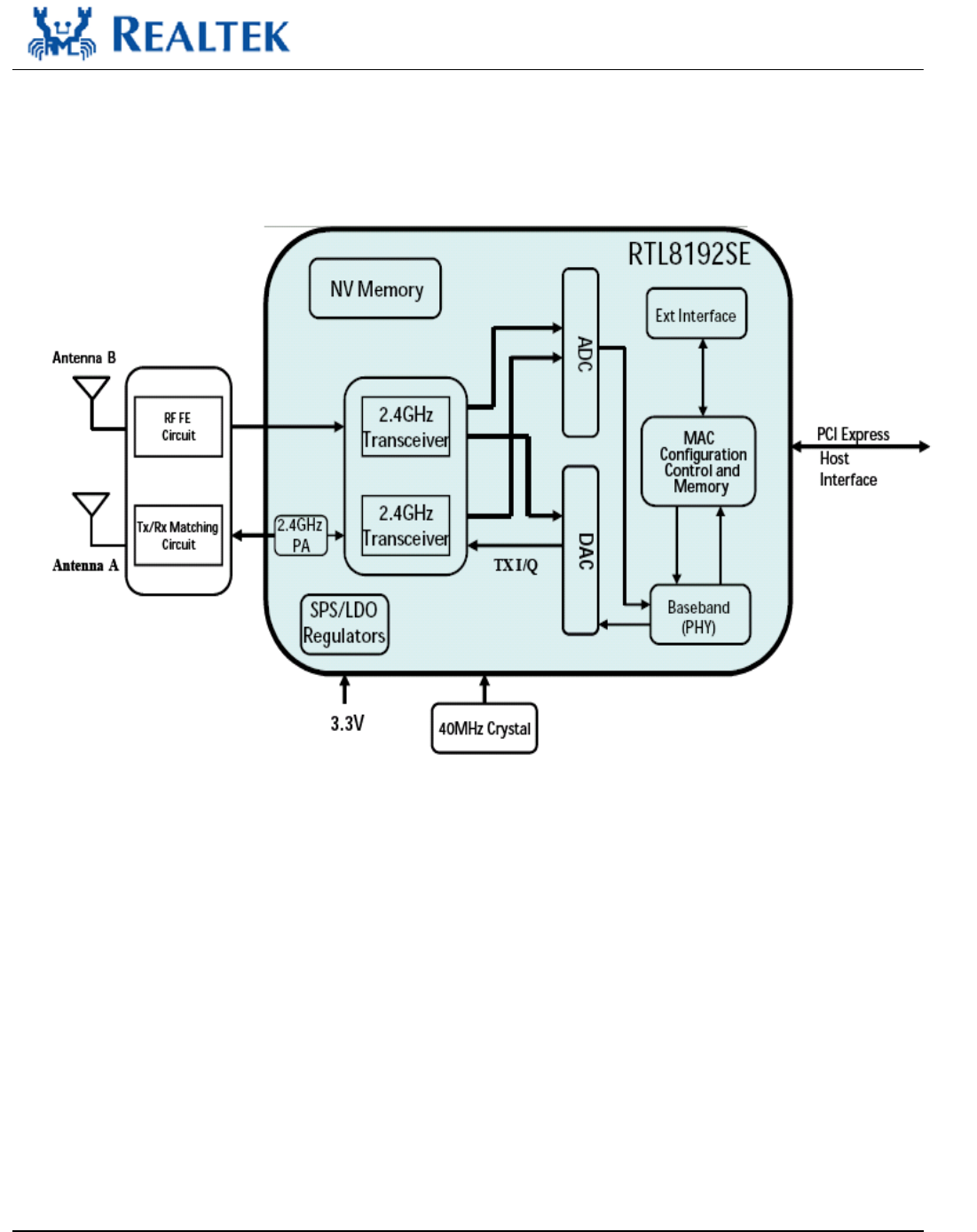
RTL8192SE
User’s Manual
7 Rev.1.0
3. Block Diagram
Figure 1. Single Band 11n Application Diagram
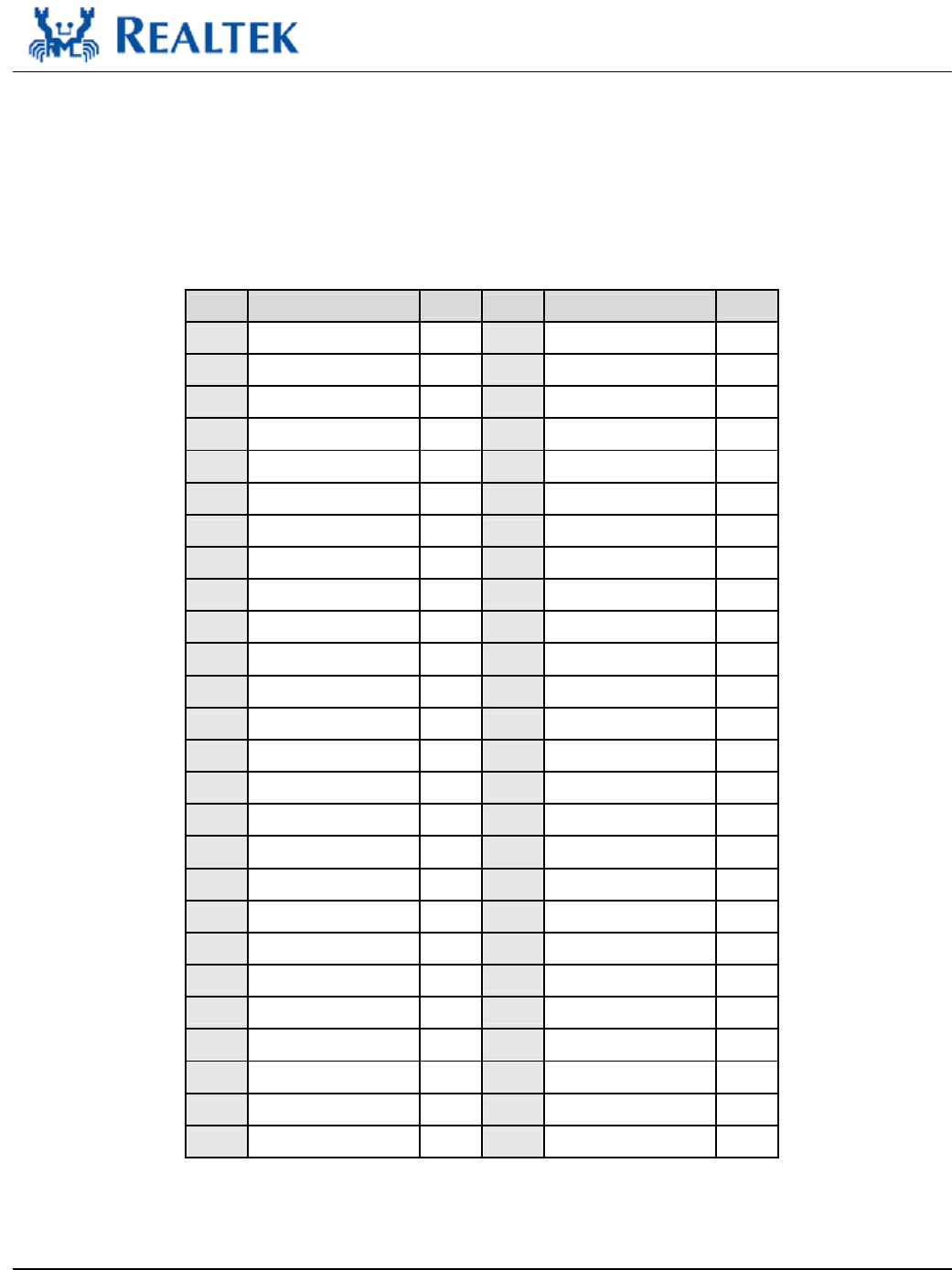
RTL8192SE
User’s Manual
8 Rev.1.0
4. Product specifications
4.1. Mini PCI Express Pin Assignment
Table 1. Mini PCI Express Pin Assignment
PIN# Pin Name PIN# Pin Name
1 WAKE# YES 2 3.3V YES
3 RESERVED NC 4 GND YES
5 RESERVED NC 6 1.5V NC
7 CLKREQ# YES 8 RESERVED NC
9 GND YES 10 RESERVED NC
11 REFCLK+ YES 12 RESERVED NC
13 REFCLK- YES 14 RESERVED NC
15 GND YES 16 RESERVED NC
17 RESERVED NC 18 GND YES
19 RESERVED NC 20 W_DISABLE# YES
21 GND YES 22 PERST# YES
23 PERn0 YES 24 +3.3Vaux YES
25 PERp0 YES 26 GND YES
27 GND YES 28 +1.5V NC
29 GND YES 30 SMB_CLK NC
31 PETn0 YES 32 SMB_DATA NC
33 PETp0 YES 34 GND YES
35 GND YES 36 USB_D- NC
37 RESERVED NC 38 USB_D+ NC
39 RESERVED NC 40 GND YES
41 RESERVED NC 42 LED_WWAN# NC
43 RESERVED NC 44 LED_WLAN# YES
45 RESERVED NC 46 LED_WPAN# NC
47 RESERVED NC 48 +1.5V NC
49 RESERVED NC 50 GND YES
51 RESERVED NC 52 +3.3V YES
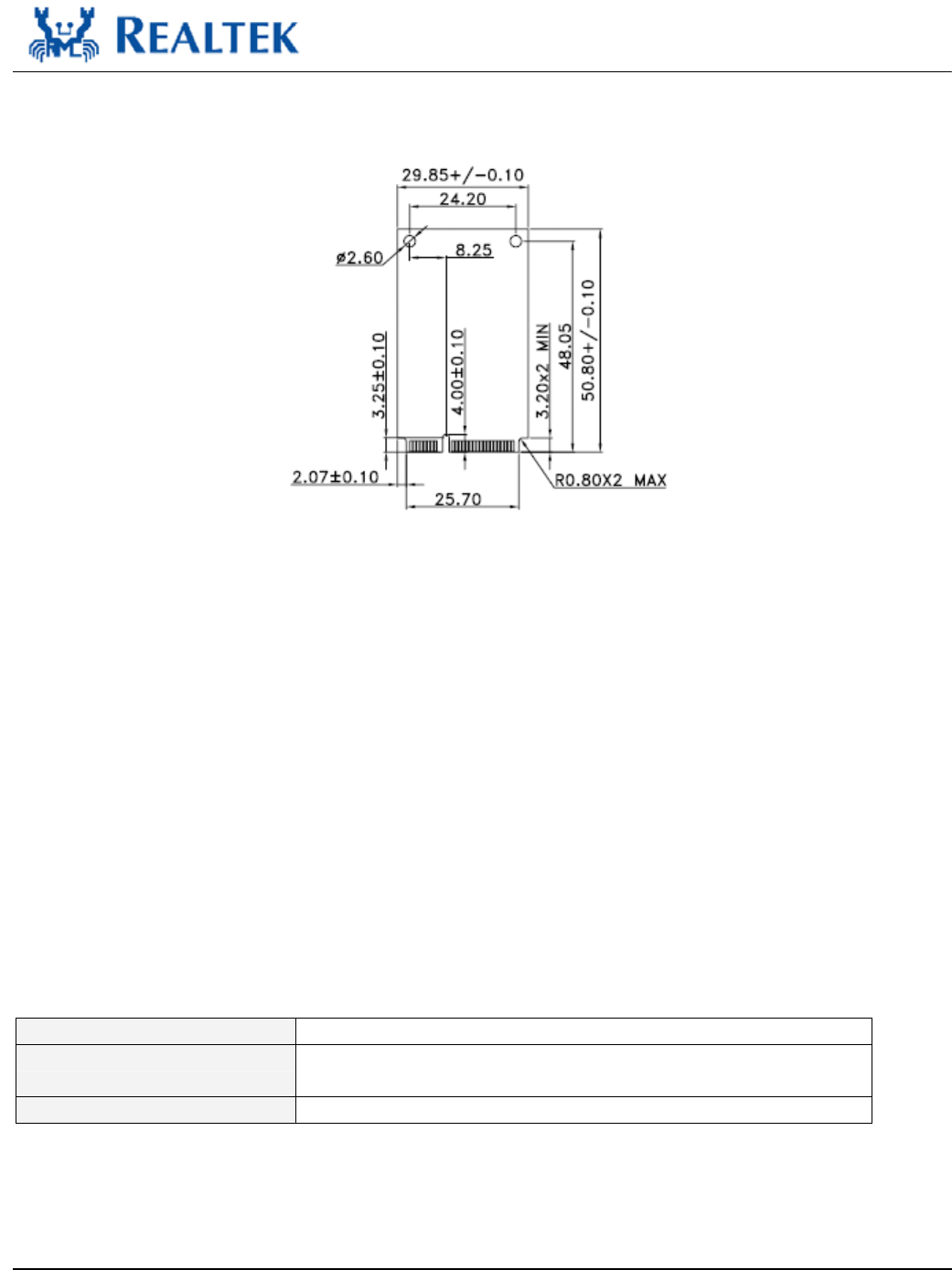
RTL8192SE
User’s Manual
9 Rev.1.0
4.2. Mechanical
Figure 2. RTL8192SE miniCard Mechanical Specification
4.3. Environmental
4.3.1. Operating
Operating Temperature: 0 to 70 °C
Relative Humidity: 5-90% (non-condensing)
4.3.2. Storage
Temperature: -55 to 125 °C
Relevant Humidity: 5-95% (non-condensing)
4.4. Functional Specifications
Table 2. Functional Specifications
POWER SUPPLY DC 3.0~3.6V from host equipment
MODULATION TYPE CCK, DQPSK, DBPSK for DSSS
64QAM, 16QAM, QPSK, BPSK for OFDM
MODULATION Technology DSSS, OFDM
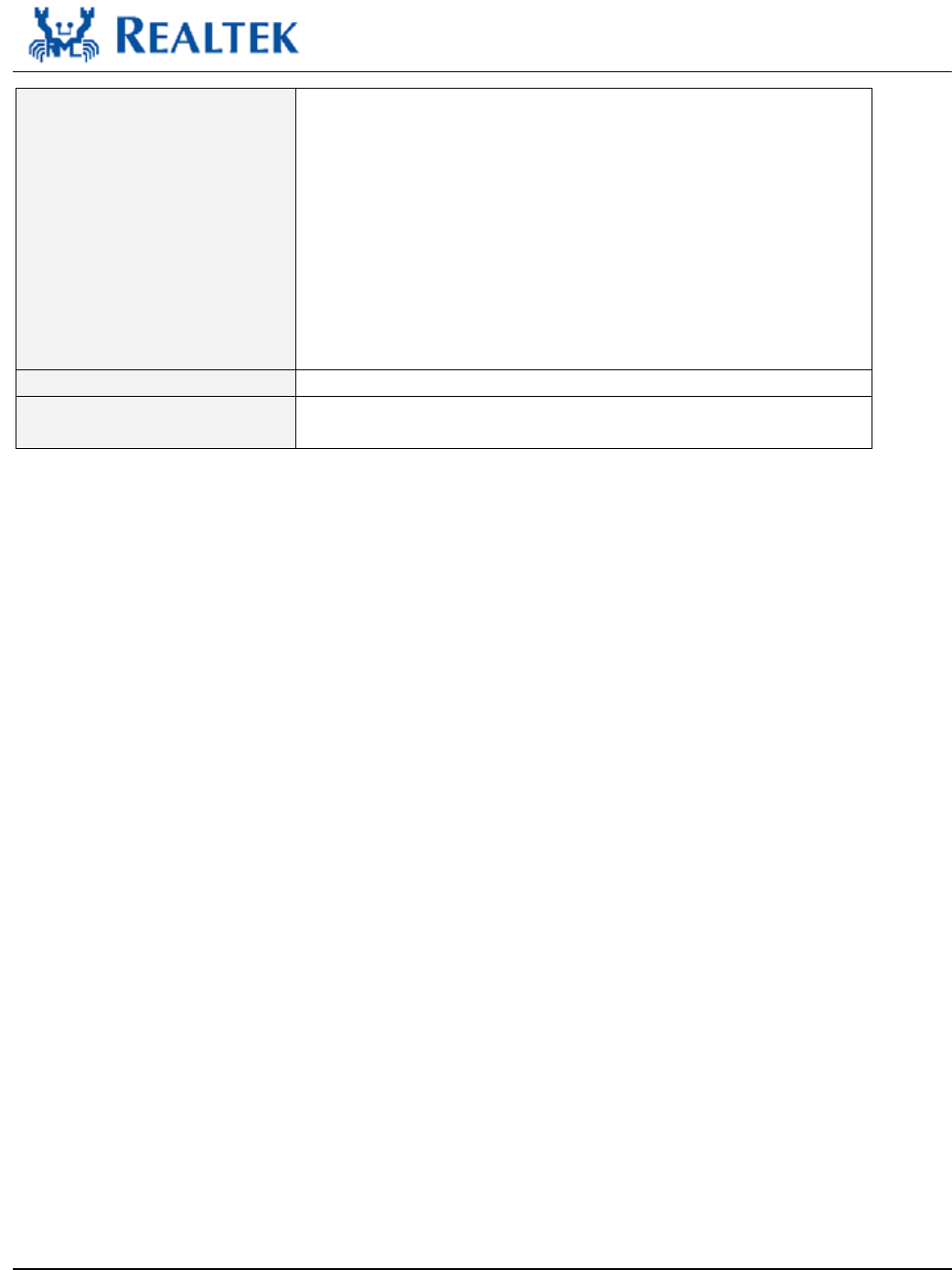
RTL8192SE
User’s Manual
10 Rev.1.0
Transfer rate 802.11b: 11 / 5.5 / 2 / 1Mbps
802.11g: 54 / 48 / 36 / 24 / 18 / 12 / 9 / 6Mbps
Draft 802.11n (20MHz, 800ns GI): 130 / 117 / 104 / 78 / 65 / 58.5
/ 52 / 39 / 26 / 19.5 / 13 / 6.5Mbps
Draft 802.11n (40MHz, 800ns GI): 270 / 243 / 216 / 162 /135 /
121.5 / 108 / 81 / 54 / 40.5 / 27 / 13.5Mbps
Draft 802.11n (20MHz, 400ns GI): 144.444 / 130 / 115.556 /
86.667 / 72.2 / 65 / 57.8 / 57.778 / 43.333 / 43.3 / 28.9 / 28.889 /
21.7 / 14.444 / 14.4 / 7.2Mbps
Draft 802.11n (40MHz, 400ns GI): 300 / 270 / 240 / 180 / 150 /
135 / 120 / 90 / 60 / 45 / 30 / 15Mbps
FREQUENCY Range 2400MHz ~ 2483.5MHz
NUMBER OF CHANNEL 11 for 802.11b, 802.11g, draft 802.11n (20MHz)
7 for draft 802.11n (40MHz)
4.5. Warning
4.5.1 Federal Communication Commission Interference Statement
This equipment has been tested and found to comply with the limits for a Class B digital device,
pursuant to Part 15 of the FCC Rules. These limits are designed to provide reasonable protection against
harmful interference in a residential installation. This equipment generates, uses and can radiate radio
frequency energy and, if not installed and used in accordance with the instructions, may cause harmful
interference to radio communications. However, there is no guarantee that interference will not occur in a
particular installation. If this equipment does cause harmful interference to radio or television reception,
which can be determined by turning the equipment off and on, the user is encouraged to try to correct the
interference by one of the following measures:
- Reorient or relocate the receiving antenna.
- Increase the separation between the equipment and receiver.
- Connect the equipment into an outlet on a circuit different from that
to which the receiver is connected.
- Consult the dealer or an experienced radio/TV technician for help.
This device complies with Part 15 of the FCC Rules. Operation is subject to the following two conditions:
(1) This device may not cause harmful interference, and (2) this device must accept any interference
received, including interference that may cause undesired operation.
FCC Caution: Any changes or modifications not expressly approved by the party responsible for
compliance could void the user's authority to operate this equipment.
IMPORTANT NOTE:
FCC Radiation Exposure Statement:
This equipment complies with FCC radiation exposure limits set forth for an uncontrolled environment.
This equipment should be installed and operated with minimum distance 20cm between the radiator & your

RTL8192SE
User’s Manual
11 Rev.1.0
body.
This transmitter must not be co-located or operating in conjunction with any other antenna or transmitter.
IEEE 802.11b or 802.11g operation of this product in the U.S.A. is firmware-limited to channels 1 through
11.
This device is intended only for OEM integrators under the following conditions:
The antenna must be installed such that 20 cm is maintained between the antenna and users, and
The transmitter module may not be co-located with any other transmitter or antenna,
For all products market in US, OEM has to limit the operation channels in CH1 to CH11 for 2.4G band by
supplied firmware programming tool. OEM shall not supply any tool or info to the end-user regarding to
Regulatory Domain change.
As long as 3 conditions above are met, further transmitter test will not be required. However, the OEM
integrator is still responsible for testing their end-product for any additional compliance requirements
required with this module installed (for example, digital device emissions, PC peripheral requirements,
etc.).
IMPORTANT NOTE: In the event that these conditions can not be met (for example certain laptop
configurations or co-location with another transmitter), then the FCC authorization is no longer considered
valid and the FCC ID can not be used on the final product. In these circumstances, the OEM integrator will
be responsible for re-evaluating the end product (including the transmitter) and obtaining a separate FCC
authorization.
End Product Labeling
This transmitter module is authorized only for use in device where the antenna may be installed such that 20
cm may be maintained between the antenna and users. The final end product must be labeled in a visible
area with the following: “Contains FCC ID: TX2-RTL8192SE”.
Manual Information To the End User
The OEM integrator has to be aware not to provide information to the end user regarding how to install or
remove this RF module in the user’s manual of the end product which integrates this module.
The end user manual shall include all required regulatory information/warning as show in this manual.
Industry Canada Statement
This device complies with RSS-210 of the Industry Canada Rules. Operation is subject to the following two
conditions:
1) this device may not cause interference and
2) this device must accept any interference, including interference that may cause undesired operation of
the device
This device has been designed to operate with an antenna having a maximum gain of 3.95 dBi.
Antenna having a higher gain is strictly prohibited per regulations of Industry Canada. The required
antenna
impedance is 50 ohms.
To reduce potential radio interference to other users, the antenna type and its gain should be so chosen that

RTL8192SE
User’s Manual
12 Rev.1.0
the EIRP is not more than required for successful communication.
IMPORTANT NOTE:
IC Radiation Exposure Statement:
This equipment complies with IC radiation exposure limits set forth for an uncontrolled environment. This
equipment should be installed and operated with minimum distance 20cm between the radiator & your
body.
4.5.2 Industry Canada Statement
This device complies with RSS-210 of the Industry Canada Rules. Operation is subject to the
following two conditions:
1) this device may not cause interference and
2) this device must accept any interference, including interference that may cause undesired operation of
the device
This device has been designed to operate with an antenna having a maximum gain of 3.95dBi.
Antenna having a higher gain is strictly prohibited per regulations of Industry Canada. The required
antenna
impedance is 50 ohms.
To reduce potential radio interference to other users, the antenna type and its gain should be so chosen that
the EIRP is not more than required for successful communication.
IMPORTANT NOTE:
IC Radiation Exposure Statement:
This equipment complies with IC radiation exposure limits set forth for an uncontrolled environment. This
equipment should be installed and operated with minimum distance 20cm between the radiator & your
body.
This device is intended only for OEM integrators
under the following conditions:
The transmitter module may not be co-located with any other transmitter or antenna.
As long as conduction above is met, further transmitter test will not be required. However, the OEM
integrator is still responsible for testing their end-product for any additional compliance requirements
required with this module installed (for example, digital device emissions, PC peripheral requirements,
etc.). The antenna must be installed such that 20 cm is maintained between the antenna and users.
IMPORTANT NOTE: In the event that these conditions can not be met (for example certain laptop
configurations or co-location with another transmitter), then the IC authorization is no longer considered
valid and the IC ID can not be used on the final product. In these circumstances, the OEM integrator will be

RTL8192SE
User’s Manual
13 Rev.1.0
responsible for re-evaluating the end product (including the transmitter) and obtaining a separate IC
authorization.
End Product Labeling
The final end product must be labeled in a visible area with the following: “Contains TX IC :
6317A-RTL8192SE”.
Manual Information That Must be Included
The OEM integrator has to be aware not to provide information to the end user regarding how to install or
remove.
This RF module in the user’s manual of the end product which integrates this module.
The user’s manual for OEM Integrators must include the following information in a prominent location
“IMPORTANT NOTE: To comply with FCC RF exposure compliance requirements. The antenna must not
be co-located or operating in conjunction with any other antenna or transmitter”.
4.5.3 NCC 警語
經型式認證合格之低功率射頻電機,非經許可,公司、商號或使用者均不得擅自變更頻率、加大功
率或變更原設計之特性及功能。
低功率射頻電機之使用不得影響飛航安全及干擾合法通信;經發現有干擾現象時,應立即停用,並
改善至無干擾時方得繼續使用。前項合法通信,指依電信法規定作業之無線電通信。低功率射頻電
機須忍受合法通信或工業、科學及醫療用電波輻射性電機設備之干擾。
本模組於取得認證後將依規定於模組本體標示審合格籤,並要求平台上標示「本產品內含射頻模
組:ID編號」
Realtek Semiconductor Corp.
Headquarters
No. 2, Innovation Road II, Hsinchu Science Park,
Hsinchu, 300, Taiwan, R.O.C.
Tel: 886-3-5780211 Fax: 886-3-5776047
www.realtek.com.tw